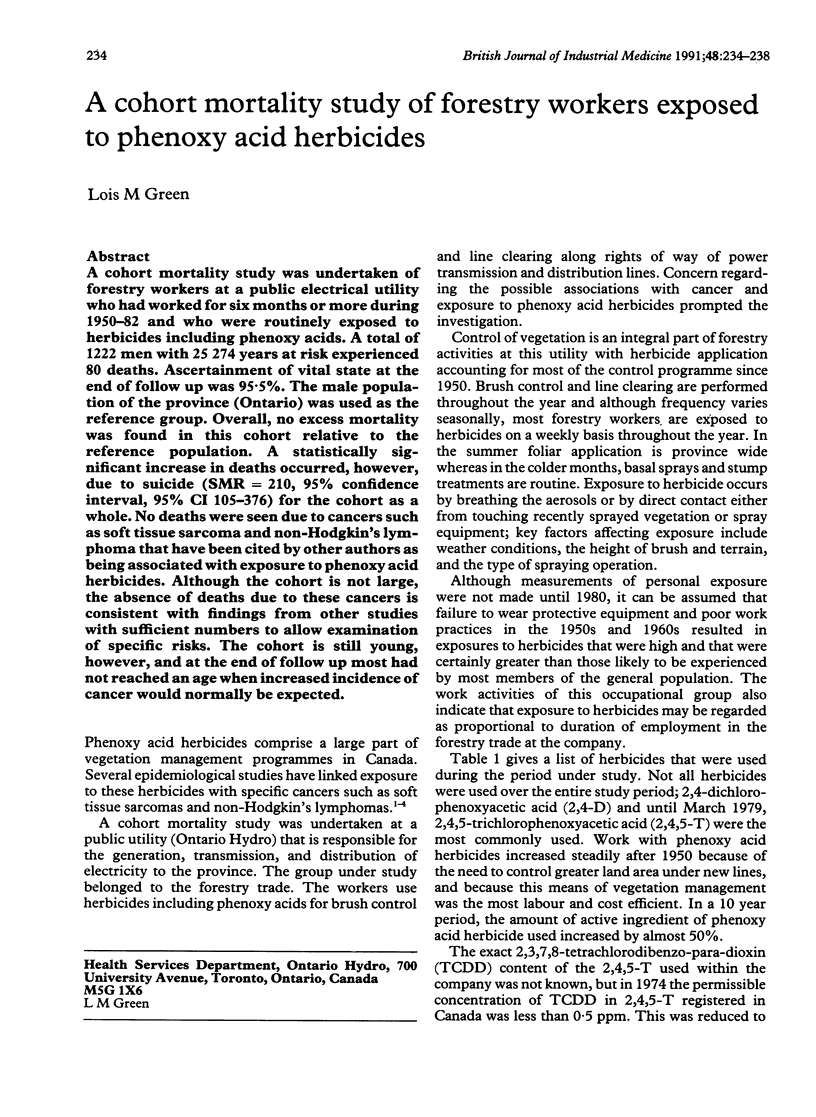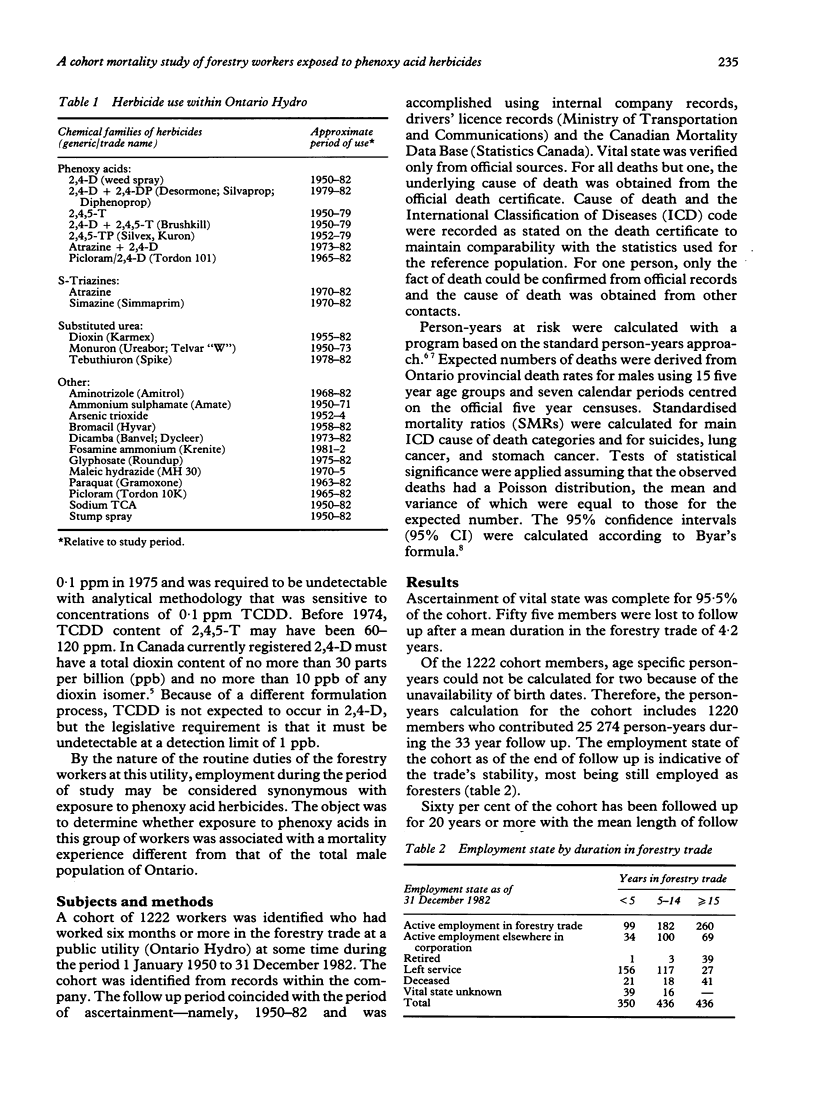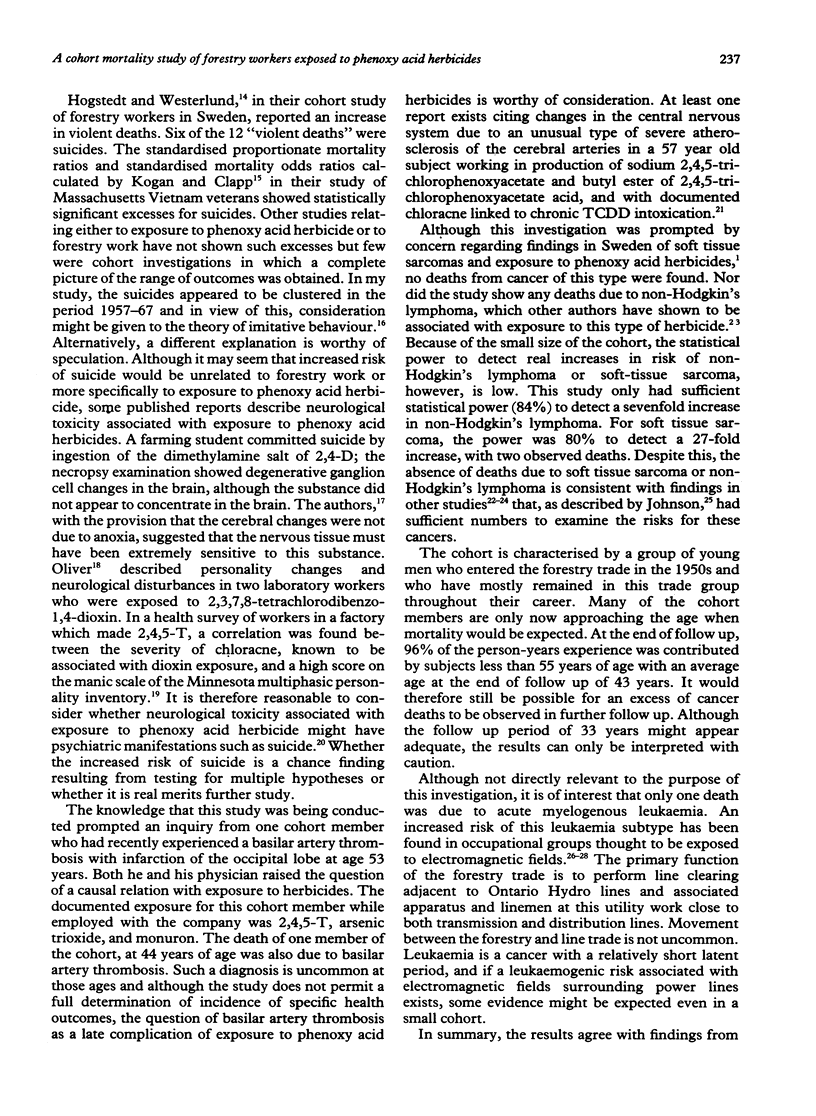Abstract
A cohort mortality study was undertaken of forestry workers at a public electrical utility who had worked for six months or more during 1950-82 and who were routinely exposed to herbicides including phenoxy acids. A total of 1222 men with 25 274 years at risk experienced 80 deaths. Ascertainment of vital state at the end of follow up was 95.5%. The male population of the province (Ontario) was used as the reference group. Overall, no excess mortality was found in this cohort relative to the reference population. A statistically significant increase in deaths occurred, however, due to suicide (SMR = 210, 95% confidence interval, 95% CI 105-376) for the cohort as a whole. No deaths were seen due to cancers such as soft tissue sarcoma and non-Hodgkin's lymphoma that have been cited by other authors as being associated with exposure to phenoxy acid herbicides. Although the cohort is not large, the absence of deaths due to these cancers is consistent with findings from other studies with sufficient numbers to allow examination of specific risks. The cohort is still young, however, and at the end of follow up most had not reached an age when increased incidence of cancer would normally be expected.
Full text
PDF




Selected References
These references are in PubMed. This may not be the complete list of references from this article.
- CASE R. A., LEA A. J. Mustard gas poisoning, chronic bronchitis, and lung cancer; an investigation into the possibility that poisoning by mustard gas in the 1914-18 war might be a factor in the production of neoplasia. Br J Prev Soc Med. 1955 Apr;9(2):62–72. doi: 10.1136/jech.9.2.62. [DOI] [PMC free article] [PubMed] [Google Scholar]
- Calle E. E., Savitz D. A. Leukemia in occupational groups with presumed exposure to electrical and magnetic fields. N Engl J Med. 1985 Dec 5;313(23):1476–1477. doi: 10.1056/nejm198512053132312. [DOI] [PubMed] [Google Scholar]
- Coggon D., Pannett B., Winter P. D., Acheson E. D., Bonsall J. Mortality of workers exposed to 2 methyl-4 chlorophenoxyacetic acid. Scand J Work Environ Health. 1986 Oct;12(5):448–454. doi: 10.5271/sjweh.2113. [DOI] [PubMed] [Google Scholar]
- DOLL R. Mortality from lung cancer in asbestos workers. Br J Ind Med. 1955 Apr;12(2):81–86. doi: 10.1136/oem.12.2.81. [DOI] [PMC free article] [PubMed] [Google Scholar]
- Doll R. Occupational cancer: a hazard for epidemiologists. Int J Epidemiol. 1985 Mar;14(1):22–31. doi: 10.1093/ije/14.1.22. [DOI] [PubMed] [Google Scholar]
- Eriksson M., Hardell L., Berg N. O., Möller T., Axelson O. Soft-tissue sarcomas and exposure to chemical substances: a case-referent study. Br J Ind Med. 1981 Feb;38(1):27–33. doi: 10.1136/oem.38.1.27. [DOI] [PMC free article] [PubMed] [Google Scholar]
- Fox A. J., Collier P. F. Low mortality rates in industrial cohort studies due to selection for work and survival in the industry. Br J Prev Soc Med. 1976 Dec;30(4):225–230. doi: 10.1136/jech.30.4.225. [DOI] [PMC free article] [PubMed] [Google Scholar]
- Green L. M. Suicide and exposure to phenoxy acid herbicides. Scand J Work Environ Health. 1987 Oct;13(5):460–460. doi: 10.5271/sjweh.2013. [DOI] [PubMed] [Google Scholar]
- Hardell L., Eriksson M., Lenner P., Lundgren E. Malignant lymphoma and exposure to chemicals, especially organic solvents, chlorophenols and phenoxy acids: a case-control study. Br J Cancer. 1981 Feb;43(2):169–176. doi: 10.1038/bjc.1981.25. [DOI] [PMC free article] [PubMed] [Google Scholar]
- Hogstedt C., Westerlund B. Kohortstudie av dödsorsaker för skogsarbetare med och utan exposition för fenoxisyrapreparat. Lakartidningen. 1980 May 7;77(19):1828–1831. [PubMed] [Google Scholar]
- Johnson E. S. Association between soft tissue sarcomas, malignant lymphomas, and phenoxy herbicides/chlorophenols: evidence from occupational cohort studies. Fundam Appl Toxicol. 1990 Feb;14(2):219–234. doi: 10.1016/0272-0590(90)90203-v. [DOI] [PubMed] [Google Scholar]
- Koskela R. S., Järvinen E., Kolari P. J. Effect of cohort definition and follow-up length on occupational mortality rates. Scand J Work Environ Health. 1984 Oct;10(5):311–316. doi: 10.5271/sjweh.2328. [DOI] [PubMed] [Google Scholar]
- Milham S., Jr Mortality from leukemia in workers exposed to electrical and magnetic fields. N Engl J Med. 1982 Jul 22;307(4):249–249. doi: 10.1056/nejm198207223070412. [DOI] [PubMed] [Google Scholar]
- Monson R. R. Observations on the healthy worker effect. J Occup Med. 1986 Jun;28(6):425–433. doi: 10.1097/00043764-198606000-00009. [DOI] [PubMed] [Google Scholar]
- NIELSEN K., KAEMPE B., JENSEN-HOLM J. FATAL POISONING IN MAN BY 24-DICHLOROPHENOXYACETIC ACID (2,4-D): DETERMINATION OF THE AGENT IN FORENSIC MATERIALS. Acta Pharmacol Toxicol (Copenh) 1965;22:224–234. doi: 10.1111/j.1600-0773.1965.tb01818.x. [DOI] [PubMed] [Google Scholar]
- Oliver R. M. Toxic effects of 2,3,7,8 tetrachlorodibenzo 1,4 dioxin in laboratory workers. Br J Ind Med. 1975 Feb;32(1):49–53. doi: 10.1136/oem.32.1.49. [DOI] [PMC free article] [PubMed] [Google Scholar]
- Pazderova-Vejlupková J., Lukás E., Nemcova M., Pícková J., Jirásek L. The development and prognosis of chronic intoxication by tetrachlordibenzo-p-dioxin in men. Arch Environ Health. 1981 Jan-Feb;36(1):5–11. doi: 10.1080/00039896.1981.10667598. [DOI] [PubMed] [Google Scholar]
- Pearce N., Checkoway H., Shy C. Time-related factors as potential confounders and effect modifiers in studies based on an occupational cohort. Scand J Work Environ Health. 1986 Apr;12(2):97–107. doi: 10.5271/sjweh.2161. [DOI] [PubMed] [Google Scholar]
- Phillips D. P. The influence of suggestion on suicide: substantive and theoretical implications of the Werther effect. Am Sociol Rev. 1974;39(3):340–354. [PubMed] [Google Scholar]
- Poland A. P., Smith D., Metter G., Possick P. A health survey of workers in a 2,4-D and 2,4,5-T plan with special attention to chloracne, porphyria cutanea tarda, and psychologic parameters. Arch Environ Health. 1971 Mar;22(3):316–327. doi: 10.1080/00039896.1971.10665850. [DOI] [PubMed] [Google Scholar]
- Wiklund K., Dich J., Holm L. E. Soft tissue sarcoma risk in Swedish licensed pesticide applicators. J Occup Med. 1988 Oct;30(10):801–804. doi: 10.1097/00043764-198810000-00010. [DOI] [PubMed] [Google Scholar]
- Woods J. S., Polissar L., Severson R. K., Heuser L. S., Kulander B. G. Soft tissue sarcoma and non-Hodgkin's lymphoma in relation to phenoxyherbicide and chlorinated phenol exposure in western Washington. J Natl Cancer Inst. 1987 May;78(5):899–910. [PubMed] [Google Scholar]
- Wright W. E., Peters J. M., Mack T. M. Leukaemia in workers exposed to electrical and magnetic fields. Lancet. 1982 Nov 20;2(8308):1160–1161. doi: 10.1016/s0140-6736(82)92814-8. [DOI] [PubMed] [Google Scholar]


